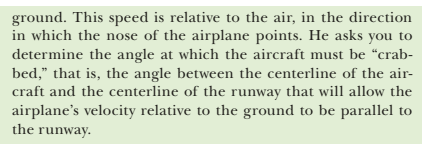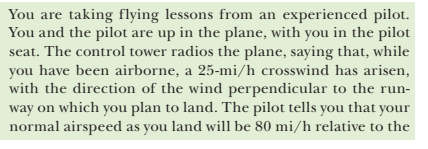ground. This speed is relative to the air, in the direction in which the nose of the airplane points. He asks you to determine the angle at which the aircraft must be “crab- bed," that is, the angle between the centerline of the air- craft and the centerline of the runway that will allow the airplane's velocity relative to the ground to be parallel to the runway.
ground. This speed is relative to the air, in the direction in which the nose of the airplane points. He asks you to determine the angle at which the aircraft must be “crab- bed," that is, the angle between the centerline of the air- craft and the centerline of the runway that will allow the airplane's velocity relative to the ground to be parallel to the runway.
Principles of Physics: A Calculus-Based Text
5th Edition
ISBN:9781133104261
Author:Raymond A. Serway, John W. Jewett
Publisher:Raymond A. Serway, John W. Jewett
Chapter3: Motion In Two Dimensions
Section: Chapter Questions
Problem 16P: A firefighter, a distance d from a burning building, directs a stream of water from a fire hose at...
Related questions
Concept explainers
Topic Video
Question

Transcribed Image Text:ground. This speed is relative to the air, in the direction
in which the nose of the airplane points. He asks you to
determine the angle at which the aircraft must be “crab-
bed," that is, the angle between the centerline of the air-
craft and the centerline of the runway that will allow the
airplane's velocity relative to the ground to be parallel to
the runway.

Transcribed Image Text:You are taking flying lessons from an experienced pilot.
You and the pilot are up in the plane, with you in the pilot
seat. The control tower radios the plane, saying that, while
you have been airborne, a 25-mi/h crosswind has arisen,
with the direction of the wind perpendicular to the run-
way on which you plan to land. The pilot tells you that your
normal airspeed as you land will be 80 mi/h relative to the
Expert Solution
This question has been solved!
Explore an expertly crafted, step-by-step solution for a thorough understanding of key concepts.
This is a popular solution!
Trending now
This is a popular solution!
Step by step
Solved in 2 steps

Knowledge Booster
Learn more about
Need a deep-dive on the concept behind this application? Look no further. Learn more about this topic, physics and related others by exploring similar questions and additional content below.Recommended textbooks for you

Principles of Physics: A Calculus-Based Text
Physics
ISBN:
9781133104261
Author:
Raymond A. Serway, John W. Jewett
Publisher:
Cengage Learning

University Physics Volume 1
Physics
ISBN:
9781938168277
Author:
William Moebs, Samuel J. Ling, Jeff Sanny
Publisher:
OpenStax - Rice University

College Physics
Physics
ISBN:
9781305952300
Author:
Raymond A. Serway, Chris Vuille
Publisher:
Cengage Learning

Principles of Physics: A Calculus-Based Text
Physics
ISBN:
9781133104261
Author:
Raymond A. Serway, John W. Jewett
Publisher:
Cengage Learning

University Physics Volume 1
Physics
ISBN:
9781938168277
Author:
William Moebs, Samuel J. Ling, Jeff Sanny
Publisher:
OpenStax - Rice University

College Physics
Physics
ISBN:
9781305952300
Author:
Raymond A. Serway, Chris Vuille
Publisher:
Cengage Learning

An Introduction to Physical Science
Physics
ISBN:
9781305079137
Author:
James Shipman, Jerry D. Wilson, Charles A. Higgins, Omar Torres
Publisher:
Cengage Learning